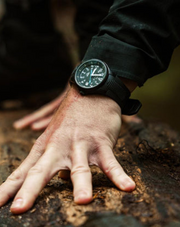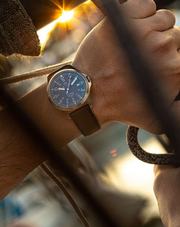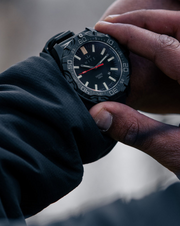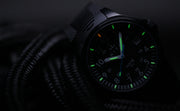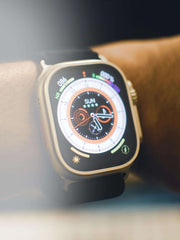Key Takeaways
- Radium provided effective illumination but posed unacceptable health risks
- Tritium emerged as a safer alternative with superior operational characteristics
- Modern tritium tubes deliver constant illumination for up to 20 years without charging
- Sealed construction eliminates health concerns whilst maintaining performance
- Professional users select tritium for its proven reliability under pressure
- NITE became the first watch company to use tritium in watches
- Tritium represents the current standard for serious luminous applications
The Evolution from Dangerous to Safe
When you're dealing with equipment that needs to perform in complete darkness, luminous technology becomes far more than just a convenience feature. The glow you see on professional timepieces today represents over a century of getting this right, moving from solutions that worked but came with serious risks to the sophisticated tritium systems we rely on now.
Here's what's interesting about this evolution: the early 1900s saw watchmakers solve a genuine operational problem with radium paint. Soldiers needed reliable time information during night operations without compromising position through visible light sources. The technology worked exactly as intended.
But by the 1960s, it became clear that radium's effectiveness came at an unacceptable cost to human health. The industry faced a fundamental challenge. At NITE, our understanding comes from recognising precisely why tritium emerged as the definitive solution for users who simply cannot afford equipment failure.
The Birth of Luminous Timekeeping
Marie and Pierre Curie's radium discovery in 1898 opened possibilities that manufacturers quickly recognised by 1910. The United States Radium Corporation developed radium-based luminous paint specifically for military timepieces during World War I, solving exactly what military operations needed: reliable time information without compromising position through visible light sources.
The technology delivered precisely what was required. Radium dials maintained bright illumination for years without any external charging. Major manufacturers like Rolex and Panerai embraced this capability immediately, creating timepieces that collectors still pursue today, though they handle them with considerably more respect now.
What made radium initially appealing was its simplicity. No charging protocols, no maintenance requirements, just consistent glow when you needed it. But radium's 1,600-year half-life and alpha particle emissions created health risks that eventually outweighed these operational advantages.
The Tritium Revolution
Tritium emerged as the solution to radium's problems. This form of hydrogen offered exactly what professionals needed: it breaks down much faster than radium (12.3 years versus 1,600), the emissions it gives off can't get through your skin, and it glows consistently throughout long operations.
Here's what makes tritium safe to use. The particles it releases are so weak they can't even get through the surface of your skin. When sealed inside specially made glass tubes with glow coating, tritium provides continuous light for decades without any health risks.
Our position at NITE comes from recognising tritium's operational advantages early in its development. While other manufacturers approached this technology cautiously, we understood that professionals required equipment that performed consistently without compromise. This recognition shaped our position as one of Britain's first brands to specialise in tritium illumination.
Understanding Modern Tritium Technology
The engineering behind today's tritium illumination is sophisticated, but the principle is straightforward enough. Tiny glass tubes get filled with pure tritium gas and coated inside with material that glows when activated. When tritium naturally breaks down, it releases particles that hit this coating, creating continuous light that needs no charging or maintenance.
Each tube gets precision-cut with lasers, filled with tritium gas, then permanently sealed. What you end up with is illumination that stays consistently bright around the clock for up to 25 years. No charging schedules, no maintenance routines.
This system's real advantage lies in its passive nature. No electronic components to fail, no charging schedules to maintain, no moving parts requiring service. The reliability this provides under demanding operational conditions simply cannot be matched by active illumination systems.
Why Professionals Choose Tritium
Professional users evaluate equipment based on performance under pressure rather than marketing specifications. Military personnel, emergency responders, and technical divers select tritium illumination because it maintains functionality when conditions become challenging and alternatives prove inadequate.
Traditional photoluminescent materials require regular charging from light sources and fade significantly during extended darkness. This limitation becomes unacceptable during operations where reliable timing information directly affects mission success and personnel safety.
When UK Special Forces selected the NITE MX10 as standard equipment, the decision reflected proven performance rather than procurement convenience. This validation comes from users who stake professional reputation and personal safety on their equipment choices. You simply cannot manufacture that kind of endorsement.
The Science Behind Safety Improvements
The transition from radium to tritium represents one of the most significant safety advances in horological engineering. Radium's alpha particle emissions could penetrate skin and accumulate in bone tissue, creating serious long-term health hazards. Tritium eliminated these concerns through fundamentally different emission characteristics.
The key difference is straightforward: tritium's beta particles lack sufficient energy to penetrate the outer layer of human skin. The sealed glass tube construction prevents any possibility of ingestion or inhalation. Even in the unlikely event of tube damage, tritium gas dissipates harmlessly rather than creating contamination risks.
Understanding what tritium actually offers helps explain why regulatory bodies worldwide have approved tritium timepieces for unrestricted daily wear. The safety improvements over historical radium technology are so substantial that tritium watches require no special handling considerations whatsoever.
NITE's Tritium Innovation Heritage
NITE became the first watch company to use tritium in watches when we launched our tritium-illuminated timepieces in 2003. This pioneering approach reflected our understanding that tritium offered performance characteristics perfectly matched to professional users who could not accept equipment limitations.
Our company heritage stems from recognising what professionals actually need from their equipment rather than what marketing departments think sounds impressive. The MX10's selection by British Special Forces validated our commitment to function-first design. This wasn't marketing achievement but operational endorsement from users whose requirements eliminate any margin for equipment failure.
Understanding Different Brightness Applications
What sets our approach apart is understanding how different tritium specifications perform in various operational contexts. The Alpha Horizon series incorporates high-brightness T100 tubes for maximum visibility in challenging conditions, whilst the MX10 utilises T25 tubes for controlled illumination that maintains tactical discretion.
Comparing Modern Tritium Technology
Contemporary tritium technology offers different brightness specifications designed for specific operational requirements. T25 tubes (containing up to 25 millicuries) provide controlled illumination suitable for tactical applications where excessive visibility could compromise position. T100 tubes (25-100 millicuries) deliver maximum brightness for situations where visibility represents the primary concern.
From our testing, professional users typically prioritise tritium's consistent performance over maximum initial brightness. Military and adventure watch selection often reflects requirements for equipment that performs reliably rather than impressively.
The choice between brightness levels usually depends on specific mission parameters. Operations requiring stealth benefit from T25's controlled output, whilst scenarios where maximum visibility ensures safety favour T100 specifications. Most users find that understanding their genuine requirements eliminates confusion around these technical specifications.
Real-World Professional Applications
Tritium illumination proves essential in environments where alternative technologies simply cannot maintain reliability. Military night operations, technical operations, underground rescue work, and emergency response create conditions that eliminate second chances for equipment failure.
Tactical and Emergency Applications
Consider tactical operations where timing is critical. During extended missions in complete darkness, traditional luminous materials become ineffective when artificial charging sources are unavailable. Tritium-equipped timepieces like the NITE Hawk Nightfall maintain consistent timing information throughout multi-hour operations, supporting critical calculations that determine mission success.
Mountain rescue teams operating in extended darkness particularly benefit from tritium's ability to provide coordination timing without compromising operational security. The constant illumination enables team synchronisation without requiring artificial light sources that could reveal positions to casualties or environmental hazards.
The Collector's Perspective
Collectors who understand technical evolution appreciate tritium as both functional advancement and historical marker. The progression from dangerous radium to safe tritium represents genuine engineering achievement rather than marketing differentiation. This understanding helps evaluate timepieces based on substance rather than brand positioning.
Our focus at NITE on proven performance rather than trend-following appeals to collectors who recognise that functional design typically maintains value better than fashion-driven approaches. While many focus on complications and finishing, there's a compelling case for appreciating the engineering that makes equipment actually work when conditions become challenging.
The Future of Luminous Technology
Luminous technology continues developing through improved tritium formulations and enhanced brightness characteristics. But for applications where reliability remains paramount, tritium's passive operation offers advantages that active systems cannot match. No battery dependence, no charging requirements, no electronic failure modes.
At NITE, our development focus remains on practical improvements that enhance real-world performance. We work closely with suppliers to optimise tritium characteristics for specific applications, ensuring our timepieces continue meeting the standards that professional users demand from essential equipment.
Making the Right Choice
Selecting tritium technology requires honest assessment of actual requirements rather than influence from marketing claims. Consider your usage patterns honestly. Do your operations involve extended periods in darkness? Are you engaged in activities where equipment reliability affects safety outcomes?
Professional users in military, emergency response, diving, and outdoor leadership consistently select tritium because their operational requirements eliminate tolerance for equipment limitations. When timing accuracy and visibility reliability affect mission success and personal safety, you need equipment that performs without compromise.
Conclusion: Illumination You Can Trust
The evolution from radium to tritium demonstrates what occurs when an industry prioritises performance and safety over cost reduction. Modern tritium technology delivers superior illumination whilst eliminating the health risks that made early luminous timepieces problematic.
Our dedication to tritium at NITE stems from understanding that illumination represents essential equipment for professionals operating under demanding conditions. Whether coordinating tactical operations, managing technical diving profiles, or requiring consistent performance regardless of environmental conditions, tritium illumination provides the reliability that professional users demand.
Experience proven tritium performance. Explore the NITE collection and discover why professionals choose equipment that performs when everything else fails.
Frequently Asked Questions
What distinguishes radium from tritium in watch illumination? Radium provided effective illumination but created health hazards through alpha particle emissions and its 1,600 year half-life. Tritium eliminates these risks with beta particles that cannot penetrate skin and a manageable 12.3 year half-life whilst delivering superior consistent illumination.
How long does tritium illumination maintain effectiveness? Quality tritium tubes provide bright, consistent illumination for up to 20 years without requiring charging or maintenance. Unlike photoluminescent materials that fade overnight, tritium maintains constant brightness throughout its operational lifespan.
Is tritium safe for daily wear? Modern tritium technology is completely safe for unrestricted daily use. The tritium remains sealed within glass tubes, and the beta particles lack sufficient energy to penetrate human skin. International regulatory bodies have extensively tested and approved tritium timepieces for consumer use.
Why do professional users prefer tritium illumination? Professionals select tritium because it provides reliable illumination without external charging requirements, maintains consistent brightness regardless of environmental conditions, and requires no maintenance protocols. When equipment failure could affect mission success or safety, tritium delivers dependable performance.
What differentiates T25 from T100 tritium specifications? T25 tritium provides controlled illumination optimal for tactical applications where discretion matters. T100 tritium offers maximum brightness for situations where visibility represents the highest priority. Both specifications provide complete safety and decades of reliable operation.



